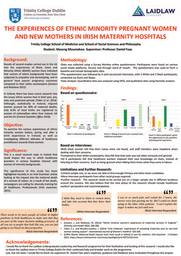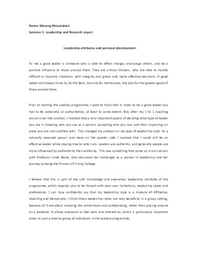Summer 1-Research Review
Review of research project:
"An exploratory study into differential treatment towards ethnic minority pregnant women and new mothers in Irish maternity hospitals
Stepping out of my comfort zone would be one way to describe how the past summer has been. For someone with a previous undergraduate degree and Master's degree, carrying out a research project is not something that is completely new to me. However, coming from a scientific background, I work really well with indisputable quantitative data, numbers, equations and results generated from lab experiments. This project was the complete opposite.
Based on my own experiences and of those around me, I decided to look into whether or not there was differential treatment of ethnic minority women in Irish maternity hospitals. Having read through a copious amount of literature of similar studies that have taken place in America and in the UK, I thought it would be pretty easy to do something similar here in Ireland...wrong. Before I go into the challenges I faced, It would be smart to explain my methodology for the project.
The idea was to collect quantitative data using an online questionnaire and then followed by an interview in order to get qualitative data. And in order to get a full picture, the questionnaire was targeted to women from 5 racial backgrounds: Black (African), Any other Black, Chinese, Any other Asian and Other (Mixed race etc.).
The questionnaire was shared on various social media platforms, on forums targeted to pregnant women and new mothers, and also shared amongst family and friends. Although this was great and we were off to a good start with 39 responses in the first 2 days, I did not anticipate the challenges that were to follow:
- Firstly, once I started analysing the results of the questionnaires I quickly realised that I couldn't use a third of the online responses as these candidates did not finish the whole survey. This significantly reduced my sample size. But, I kept sharing the survey where I could and it did result in more responses throughout the summer.
- A second challenge was that most of the people who responded were from the Black (African) racial group, which didn't really help for comparison. However, before sending out the survey my supervisor and I decided to add 2 more racial groups to the questionnaire: "White Irish", and "Any other white". The logic behind this was that it would be beneficial to have a control group. Again, with pushing the survey out a bit more and even reaching out to individuals on more platforms, we were able to increase the number of responses from Non-Black participants.
- Lastly, another challenge was that even with all the sharing of the survey, I had no participants from Chinese background and only one from the "Any other asian" background. This was when my supervisor suggested I bring paper copies to places where I knew people from this racial background frequented. This led to 3 filled out surveys from Chinese individuals.
Although the goal was to get 10 questionnaire responses from each racial group, it became very clear that it wouldn't happen in 6 weeks. As well as this, I also started carrying out interviews while I waited to get more responses, because the weeks were going by so fast.
In the end, I had 4 interviews: 2 interviews from the Black group and 2 from the White group. Interviewing the ladies made me realise just how impactful this project is and the changes it could potentially lead to. I felt their disappointment, their sadness and also their need to be heard. Which was one of the main points I got from the interview, the women felt that they were not heard or listened to throughout their experiences in the hospitals. In the end, the qualitative data will be a comparison between the experiences of Black women vs. White women, due to no interviews carried out with other racial groups. Carrying out the interviews was very different for me, because as much as it was a relaxed conversational style, it was very difficult to separate my own biases from the conversation; or not being obvious about whether or not I agreed/disagreed with the interviewees.
Regardless of the shortcomings of the research: Such as not getting enough participants from all the racial groups, and also having a small sample size for interview. However, I still really believe in the impact this study could have on Irish maternity care and how women are treated. And it would be something I would definitely be interested in looking at in more depth for my Leadership in Action project.


Please sign in
If you are a registered user on Laidlaw Scholars Network, please sign in